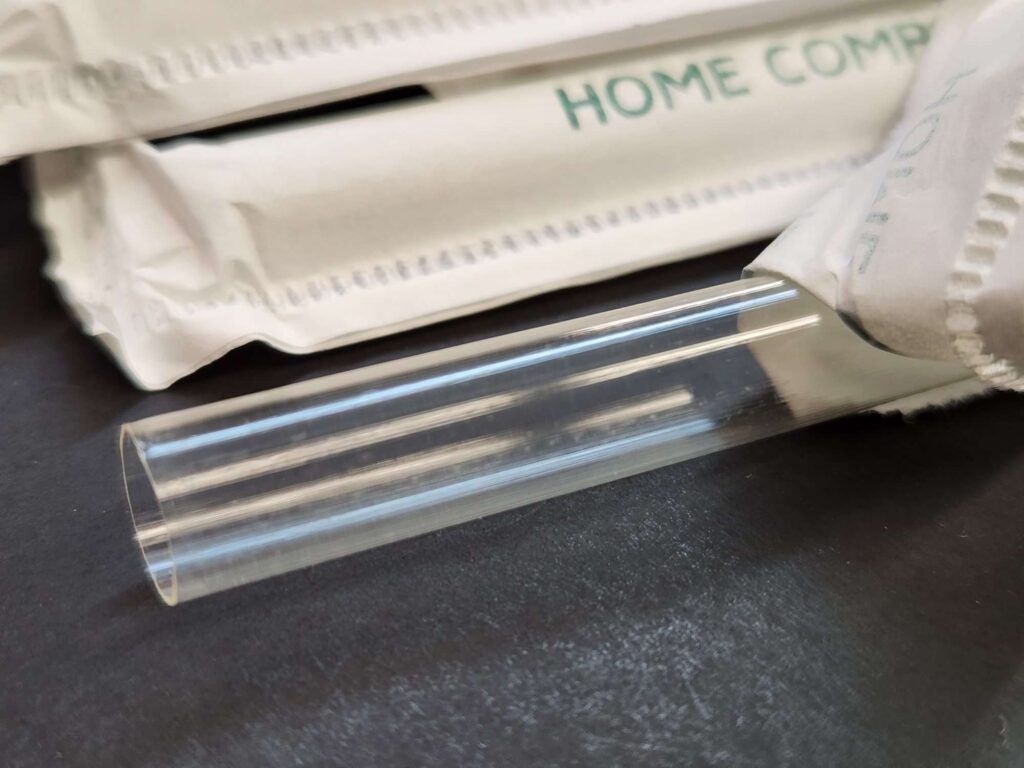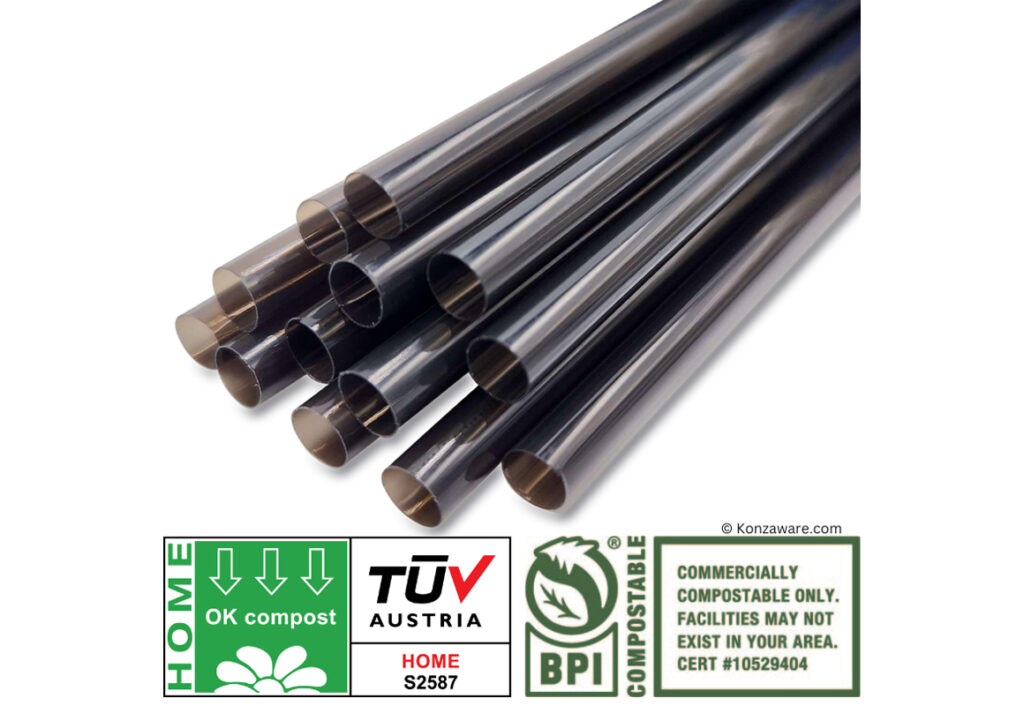Introduction
In this article, we will delve into the comparison between Konzaware straws vs PLA (Polylactic Acid) straws to help you make an informed decision for your sustainable straw needs. As the world becomes more conscious of the environmental impact of single-use plastics, alternatives such as Konzaware straws and PLA straws have gained popularity.
Konzaware straws are a type of sustainable straw made from sustainable wood pulp that is used to create biodegradable plastic. These straws are designed to be durable, reusable, and biodegradable. They are an excellent choice for those looking for an eco-friendly alternative to traditional plastic straws.
On the other hand, PLA straws are made from Polylactic Acid, a biodegradable and compostable material derived from renewable resources such as cornstarch. PLA straws are known for their strength and ability to withstand high temperatures, making them suitable for both hot and cold beverages.
Comparing Konzaware straws vs PLA straws offer numerous benefits. Konzaware straws are biodegradable but also reusable, making them a sustainable option for those who want to reduce their plastic waste. They are also free from harmful chemicals such as BPA and PFAS, ensuring a safe drinking experience. They are naturally clear in appearance and look and feel like regular plastic straws. They disintegrate with no remaining microplastics to create healthy soil for plant life.
PLA straws, on the other hand, are industrial compostable, meaning they can break down in an industrial composting facility. They are also heat-resistant, making them suitable for a wide range of beverages. Additionally, PLA straws have a smooth texture and do not alter the taste of the drink.
In the following sections of this article, we will further explore the benefits, drawbacks, sustainability, durability, and overall performance of Konzaware straws and PLA straws. By the end, you will have a comprehensive understanding of these two types of straws, allowing you to make an informed decision on which one is the superior choice for your specific needs.
What are Konzaware Straws?
Konzaware straws are a type of sustainable straw that is gaining popularity in the market. These straws are made from sustainable wood pulp that are designed to be eco-friendly and durable. The main material used in Konzaware straws is both soil and marine biodegradable which is extremely good for the environment.
One of the key features of Konzaware straws is their sustainability. The use of wood pulp material helps to reduce waste and promote a circular economy. These articles can be diverted from the landfill to the home compost heap. They disintegrate in weeks to create healthy soil for plant life.
In addition to their sustainability, Konzaware straws also offer several other benefits. They are BPA-free, PFAS-free and non-toxic, ensuring that they are safe for both adults and children to use. The straws come in a variety of sizes and colors, allowing users to choose the option that best suits their needs and preferences.
Overall, Konzaware straws are a great choice for those who are looking for a sustainable alternative to traditional plastic straws. They offer the durability and performance of regular plastic straws while minimizing their environmental impact. With their unique material and commitment to sustainability, Konzaware straws are a superior choice for those who want to make a positive change in their daily lives.
What are PLA Straws?
PLA straws, also known as Polylactic Acid straws, are a type of biodegradable straw made from renewable resources such as cornstarch. PLA is a bioplastic that is derived from plant-based materials, making it an eco-friendly alternative to traditional plastic straws. These straws are designed to break down in an industrial composting facility, reducing their impact on the environment.
On the other hand, Konzaware straws are made from sustainable wood pulp. These straws are crafted using a unique manufacturing process that ensures they are sturdy and durable while still being environmentally friendly. The wood pulp used in Konzaware straws comes from responsibly managed forests, making them a sustainable choice for those looking to reduce their carbon footprint.

While both PLA straws and Konzaware straws are eco-friendly alternatives to plastic straws, there are some differences between the two. PLA straws are made from plant-based materials, which means they require less energy and resources to produce compared to traditional plastic straws. They are also industrial compostable, meaning they can break down into organic matter when disposed of properly.
On the other hand, Konzaware straws offer a unique advantage with their use of sustainable wood pulp. Wood pulp is a renewable resource that can be harvested without causing harm to the environment. This makes Konzaware straws a more sustainable option for those who are concerned about deforestation and the impact of their choices on the planet.
In terms of performance, both PLA straws and Konzaware straws are designed to be durable and functional. They can withstand warm and cold beverages without losing their shape or integrity. However, Konzaware straws may have a slight advantage in terms of durability due to their flexibility and non-brittleness.
In conclusion, PLA straws and Konzaware straws are both excellent alternatives to plastic straws. PLA straws are made from plant-based materials and are industrial compostable, while Konzaware straws are made from sustainable wood pulp and backyard or home compostable. The choice between the two ultimately depends on personal preferences, priorities and whether you have access to an industrial composting facility to process the PLA straws. Both options contribute to reducing plastic waste and promoting sustainability, making them a superior choice compared to traditional plastic straws.
Benefits of Konzaware Straws
Konzaware straws offer a range of benefits that make them a superior choice for those looking for sustainable straw options. Here are some of the key advantages of using Konzaware straws:
1. Eco-friendly: Konzaware straws are made from 100% natural and renewable materials. This means that they are biodegradable and home compostable, not industrial compostable, making them a great alternative to single-use plastic straws that contribute to environmental pollution.
2. Safe and non-toxic: Unlike some plastic straws that may contain harmful chemicals, Konzaware straws are free from BPA, PFAS, and other toxins. This makes them a safe option for both adults and children to use.
3. Versatility: Konzaware straws come in various sizes and styles, making them suitable for different types of beverages. They come in clear and black, wrapped and unwrapped 8″ Jumbo straws. They are also available as 8″ Giant wrapped straws which are great for smoothies. They are also available at 10″ Jumbo straws and Giant straws, wrapped and unwrapped, clear and black. These long sustainable straws are perfect for tall drinks or frozen drinks like you find at convenience stores. They’re also available as 5.5″ black Jumbo unwrapped cocktail straws.
Whether you prefer sipping on a smoothie, cocktail, or warm beverage, there is a Konzaware straw that will meet your needs. The versatility of these straws makes them a practical choice for individuals and businesses in the food and beverage industry.
4. Easy to dispose: Konzaware straws are designed to be compostable in your backyard compost heap. This keeps waste from filling our landfills.
5. Durable: Despite being made from natural materials, Konzaware straws are surprisingly durable and can withstand regular use. They are less likely to break or become damaged compared to PLA straws, which can sometimes be more brittle.
6. Cost-effective: While the initial cost of Konzaware straws may be slightly higher than plastic, their long-term cost-effectiveness cannot be overlooked.
Overall, Konzaware straws offer a range of benefits that make them an excellent choice for those looking to reduce their environmental impact and make more sustainable choices. Their eco-friendly nature, safety, versatility, durability, and cost-effectiveness make them a superior option compared to PLA straws. By choosing Konzaware straws, individuals can enjoy their favorite beverages while also contributing to a greener and cleaner planet.
Benefits of PLA Straws
PLA (Polylactic Acid) is a biodegradable and bioactive thermoplastic derived from renewable resources such as corn starch or sugarcane. Using PLA to make drinking straws can offer several benefits:
1. Environmental Friendliness: PLA is compostable under certain conditions, which makes PLA-based straws a more environmentally friendly alternative to traditional plastic straws made from fossil fuels. As they break down, PLA straws release fewer harmful pollutants into the environment.
2. Reduced Carbon Footprint: The production of PLA generates fewer greenhouse gas emissions compared to conventional plastics. PLA is made from renewable plant-based sources, which require less fossil fuel consumption during manufacturing, thus reducing the overall carbon footprint.
3. Non-Toxic and Food Safe: PLA is considered safe for use in contact with food and beverages. It doesn’t contain toxic chemicals like BPA (bisphenol A) that are found in some traditional plastic products. This makes PLA straws a safer choice for consumers.
4. Sturdy and Functional: PLA-based straws can provide a similar level of functionality and durability as traditional plastic straws. They are strong enough to withstand typical usage and won’t break down easily while in use.
5. Promotes Renewable Resources: PLA is derived from renewable resources like corn starch or sugarcane, which reduces the dependence on non-renewable fossil fuels. This supports the development of a more sustainable and circular economy.
However, it’s important to note that while PLA straws offer these benefits, their environmental impact can still be influenced by factors such as proper disposal and industrial composting infrastructure. If not disposed of properly, they might not fully break down or compost as expected. Always make sure to follow local guidelines for proper disposal and recycling of PLA products.
Drawbacks of Konzaware Straws
While Konzaware straws have many benefits, it is important to also consider their drawbacks. One of the main drawbacks of Konzaware straws is their limited availability. As they are made from sustainable wood pulp, they have become very popular thereby increasing demand. This means that they may not be as readily available as PLA straws, which have been on the market for some time.
Despite these drawbacks, Konzaware straws still offer a sustainable alternative to traditional plastic straws. Their use of sustainable wood pulp helps reduce the reliance on non-renewable resources and contributes to a more eco-friendly lifestyle. Furthermore, Konzaware straws are biodegradable and home compostable, meaning they will break down naturally over time, minimizing their impact on the environment.
In conclusion, while Konzaware straws have some drawbacks such as limited availability, they still offer a sustainable and eco-friendly alternative to traditional plastic straws. Their use of sustainable wood pulp and biodegradability make them an attractive option for individuals looking to reduce their environmental footprint.
Drawbacks of PLA Straws
While PLA straws have many benefits, it is important to also consider their drawbacks before making a decision. Here are some potential drawbacks of PLA straws:
1. Brittleness: PLA straws have been known to be brittle and can actually splinter, thereby causing harm to the consumer.
2. Compostability: PLA straws require that you divert the straws to an industrial composting facility in order for the straws break down and disintegrate. Unfortunately there are not many such facilities around the country. Without sending the straws to an industrial composting facility, they act like a regular plastic straw to take decades to break down, if even then.
3. Soil and Marine Biodegradable: While Konzaware straws are both soil and marine biodegradable, PLA straws are not. They behave like a regular plastic straw if not disposed of in an industrial composting facility. They will not disintegrate over time in a marine environment like KonzaWare straws.
It is important to weigh these drawbacks against the benefits of PLA straws and consider your specific needs and preferences when making a decision. While they may have some limitations, PLA straws can still offer a sustainable and eco-friendly alternative to single-use plastic straws when industrial composting facilities are available.
Sustainability Comparison
In this section, we will compare the sustainability aspects of Konzaware straws vs PLA straws. Sustainability is a crucial factor to consider when choosing a straw, as the environmental impact of single-use plastics has become a growing concern.
Konzaware straws are made from wood pulp or cellulose acetate. The material is renewable and biodegradable, making Konzaware straws an eco-friendly alternative to traditional plastic straws. By using natural materials, Konzaware straws help reduce the reliance on fossil fuels and minimize the carbon footprint associated with their production.
On the other hand, PLA straws are made from Polylactic Acid, which is derived from renewable resources such as cornstarch. PLA is a bioplastic that is compostable under specific conditions, making it a popular choice for those seeking environmentally friendly options. PLA straws break down into carbon dioxide and water when industrial composted, reducing the amount of waste that ends up in landfills.
When comparing the sustainability of Konzaware straws and PLA straws, it is important to consider the entire life cycle of the product. While both options are more sustainable than traditional plastic straws, Konzaware straws have the advantage of being made from a soil and marine biodegradable material, whereas PLA straws are made from a single bioplastic material that acts in many ways like a regular brittle plastic.
Additionally, the production process of Konzaware straws involves minimal energy consumption and does not require the use of harmful chemicals. This further enhances their sustainability credentials.
In conclusion, both Konzaware straws and PLA straws offer sustainable alternatives to traditional plastic straws. However, Konzaware straws stand out for their use of sustainable wood pulp that is soil and marine degradable, as well as their minimal energy consumption during production. If sustainability is a top priority for you, Konzaware straws may be the superior choice.
Durability and Performance Comparison
When it comes to durability and performance, both Konzaware straws and PLA straws have their own unique characteristics.
Konzaware straws are known for their exceptional durability. These straws are designed to withstand frequent use and are resistant to bending or breaking. Whether you’re sipping on a warm beverage or enjoying a cold drink, Konzaware straws are built to last.
On the other hand, PLA straws are also durable but may not be as flexible as Konzaware straws. While PLA straws can hold up well under normal use, they may not be as resistant to bending or breaking as Konzaware straws.
In terms of performance, both types of straws offer a smooth and enjoyable drinking experience. Konzaware straws have a sleek design that allows for easy sipping experience that is similar to traditional plastic straws. Both drinking straws have a smooth texture and feel that consumers are used to and expect.

It’s important to note that the performance and durability of both Konzaware straws and PLA straws can vary depending on individual usage and care.
In conclusion, both Konzaware straws and PLA straws have their own strengths when it comes to durability and performance. Konzaware straws are known for their exceptional durability and resistance to bending or breaking, along with being soil and marine biodegradable.
KonzaWare Straws vs PLA: Conclusion and Recommendation
In conclusion, after a thorough comparison between Konzaware straws and PLA straws, it is clear that both options have their own set of benefits and drawbacks.
Konzaware straws, made from sustainable wood pulp, offer several advantages. Firstly, they are biodegradable and home compostable, making them an excellent choice for those looking for eco-friendly alternatives to single-use plastic straws. Additionally, Konzaware straws are durable and can withstand warm and cold beverages without compromising their structural integrity. They are naturally clear in appearance, adding a touch of elegance to any drink.
On the other hand, PLA straws, which are made from Polylactic Acid, also have their own merits. PLA straws are derived from renewable resources such as cornstarch, making them a sustainable option. They are also biodegradable and compostable, reducing their environmental impact. PLA straws are heat-resistant and can be used with both warm and cold beverages. However, they may not be as durable as Konzaware straws and can become brittle over time.
When it comes to sustainability – Konzaware straws vs PLA – both straws are excellent choices. They are both biodegradable and compostable, ensuring that they do not contribute to the growing plastic waste problem. However, Konzaware straws have the added advantage of being certified home compostable, which further reduces their environmental footprint, while creating a circular economy.
In terms of durability and performance, Konzaware straws have the edge. Their sturdy construction allows them to withstand prolonged use without breaking or becoming brittle. PLA straws, while suitable for most beverages, may not be as durable and may require more frequent replacements due to their brittleness.
Based on the comparison, our recommendation for the superior choice would be Konzaware straws. Their sustainable wood pulp material, combined with their durability and overall performance, make them an excellent option for those seeking a reliable and eco-friendly straw.
In conclusion, whether you choose Konzaware straws or PLA straws, both options offer sustainable alternatives to single-use plastic straws. Consider your specific needs and preferences to make an informed decision that aligns with your values and contributes to a greener future.


